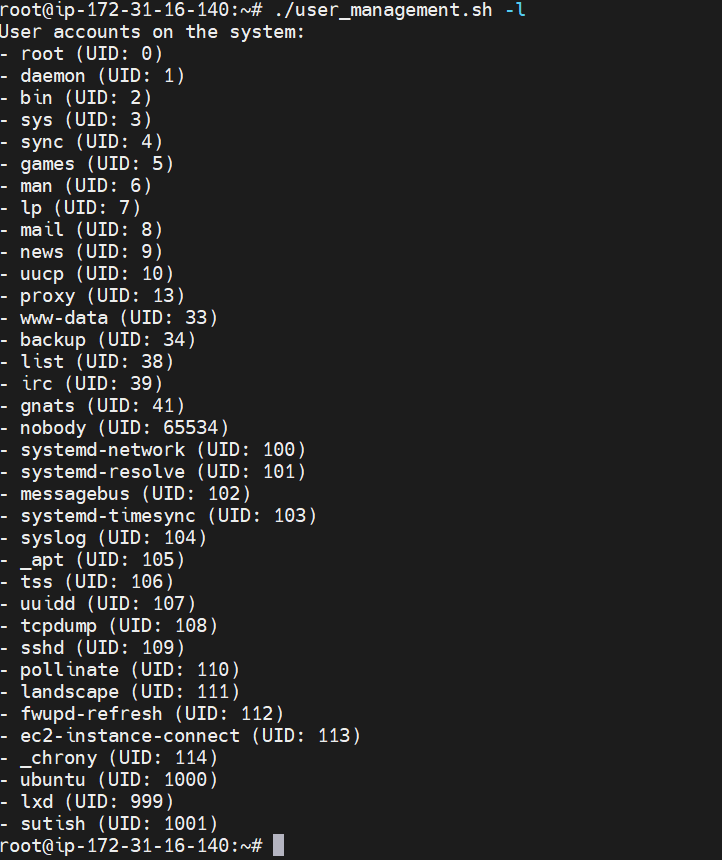Day 3 of the Bash Scripting Challenge! 🚀
 sutish pradhan
sutish pradhan
User Account Management
Task 1: Account Creation
we need to write a bash script that creates a user account. Here, the script should prompt the user to enter a new username and password.
the script checks whether the username is available before creating the account. If the username already exists, display an appropriate message and exit gracefully.
After creating the account, display a success message with the newly created username.
# Function to create a new user account
function create_user {
read -p "Enter the new username: " username
# Check if the username already exists
if id "$username" &>/dev/null; then
echo "Error: The username '$username' already exists. Please choose a different username."
else
# Prompt for password (Note: You might want to use 'read -s' to hide the password input)
read -p "Enter the password for $username: " password
# Create the user account
useradd -m -p "$password" "$username"
echo "User account '$username' created successfully."
fi
}
Task 2: Account Deletion
Let's try to perform the deletion of a user account. The script should prompt the user to enter the username of the account to be deleted.
The script checks whether the username exists before attempting to delete the account. If the username does not exist, display an appropriate message and exit gracefully.
After successfully deleting the account, display a confirmation message with the deleted username.
# Function to delete an existing user account
function delete_user {
read -p "Enter the username to delete: " username
# Check if the username exists
if id "$username" &>/dev/null; then
userdel -r "$username" # -r flag removes the user's home directory
echo "User account '$username' deleted successfully."
else
echo "Error: The username '$username' does not exist. Please enter a valid username."
fi
}
Task 3: Password Reset
The script should prompt the user to enter the username and the new password.
Ensure that the script checks whether the username exists before attempting to reset the password. If the username does not exist, display an appropriate message and exit gracefully.
After resetting the password, display a success message with the username and the updated password.
# Function to reset the password for an existing user account
function reset_password {
read -p "Enter the username to reset password: " username
# Check if the username exists
if id "$username" &>/dev/null; then
# Prompt for password (Note: You might want to use 'read -s' to hide the password input)
read -p "Enter the new password for $username: " password
# Set the new password
echo "$username:$password" | chpasswd
echo "Password for user '$username' reset successfully."
else
echo "Error: The username '$username' does not exist. Please enter a valid username."
fi
}
Task 4: List User Accounts
The script should display the usernames and their corresponding user IDs (UID).
# Function to list all user accounts on the system
function list_users {
echo "User accounts on the system:"
cat /etc/passwd | awk -F: '{ print "- " $1 " (UID: " $3 ")" }'
}
Task 5: Help and Usage Information
Now finally we need to add a help option to display usage information and the available command-line options. So let's write a function for the same.
# Check if no arguments are provided or if the -h or --help option is given
if [ $# -eq 0 ] || [ "$1" = "-h" ] || [ "$1" = "--help" ]; then
display_usage
exit 0
fi
# Command-line argument parsing
while [ $# -gt 0 ]; do
case "$1" in
-c|--create)
create_user
;;
-d|--delete)
delete_user
;;
-r|--reset)
reset_password
;;
-l|--list)
list_users
;;
*)
echo "Error: Invalid option '$1'. Use '--help' to see available options."
exit 1
;;
esac
shift
done
Final Script
#!/bin/bash
# Function to display usage information and available options
function display_usage {
echo "Usage: $0 [OPTIONS]"
echo "Options:"
echo " -c, --create Create a new user account."
echo " -d, --delete Delete an existing user account."
echo " -r, --reset Reset password for an existing user account."
echo " -l, --list List all user accounts on the system."
echo " -h, --help Display this help and exit."
}
# Function to create a new user account
function create_user {
read -p "Enter the new username: " username
# Check if the username already exists
if id "$username" &>/dev/null; then
echo "Error: The username '$username' already exists. Please choose a different username."
else
# Prompt for password (Note: You might want to use 'read -s' to hide the password input)
read -p "Enter the password for $username: " password
# Create the user account
useradd -m -p "$password" "$username"
echo "User account '$username' created successfully."
fi
}
# Function to delete an existing user account
function delete_user {
read -p "Enter the username to delete: " username
# Check if the username exists
if id "$username" &>/dev/null; then
userdel -r "$username" # -r flag removes the user's home directory
echo "User account '$username' deleted successfully."
else
echo "Error: The username '$username' does not exist. Please enter a valid username."
fi
}
# Function to reset the password for an existing user account
function reset_password {
read -p "Enter the username to reset password: " username
# Check if the username exists
if id "$username" &>/dev/null; then
# Prompt for password (Note: You might want to use 'read -s' to hide the password input)
read -p "Enter the new password for $username: " password
# Set the new password
echo "$username:$password" | chpasswd
echo "Password for user '$username' reset successfully."
else
echo "Error: The username '$username' does not exist. Please enter a valid username."
fi
}
# Function to list all user accounts on the system
function list_users {
echo "User accounts on the system:"
cat /etc/passwd | awk -F: '{ print "- " $1 " (UID: " $3 ")" }'
}
# Check if no arguments are provided or if the -h or --help option is given
if [ $# -eq 0 ] || [ "$1" = "-h" ] || [ "$1" = "--help" ]; then
display_usage
exit 0
fi
# Command-line argument parsing
while [ $# -gt 0 ]; do
case "$1" in
-c|--create)
create_user
;;
-d|--delete)
delete_user
;;
-r|--reset)
reset_password
;;
-l|--list)
list_users
;;
*)
echo "Error: Invalid option '$1'. Use '--help' to see available options."
exit 1
;;
esac
shift
done
Instructions for running the script:
Write the script and save it as
user_management.shMake the script executable using chmod :
chmod 766 user_management.shExecute the script for the required options as follows:
Create a new user: ./
user_management.sh -cDelete an existing user: ./
user_management.sh -dReset user password: ./
user_management.sh -rList all user accounts: ./
user_management.sh -lDisplay help: ./
user_management.sh-h
Output
Create a new user: ./user_management.sh -c

Delete an existing user: ./user_management.sh -d

Reset user password: ./user_management.sh -r

List all user accounts: ./user_management.sh -l

Display help: ./user_management.sh-h

Thank you for reading!
Contact me at :
Linkedin: https://www.linkedin.com/in/sutish-pradhan/
E-mail: psutish@gmail.com
Subscribe to my newsletter
Read articles from sutish pradhan directly inside your inbox. Subscribe to the newsletter, and don't miss out.
Written by

sutish pradhan
sutish pradhan
Hey there! I am Sutish I am a Devops engineer, started writing articles on my DevOps and cloud journey. My purpose is to share the concepts that I learn, the projects that I build, and the tasks that I perform regarding DevOps. Hope you all find it useful.